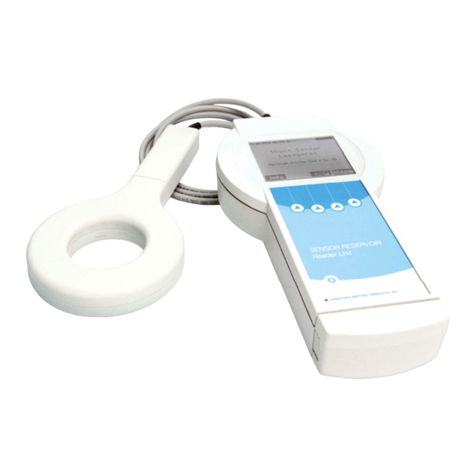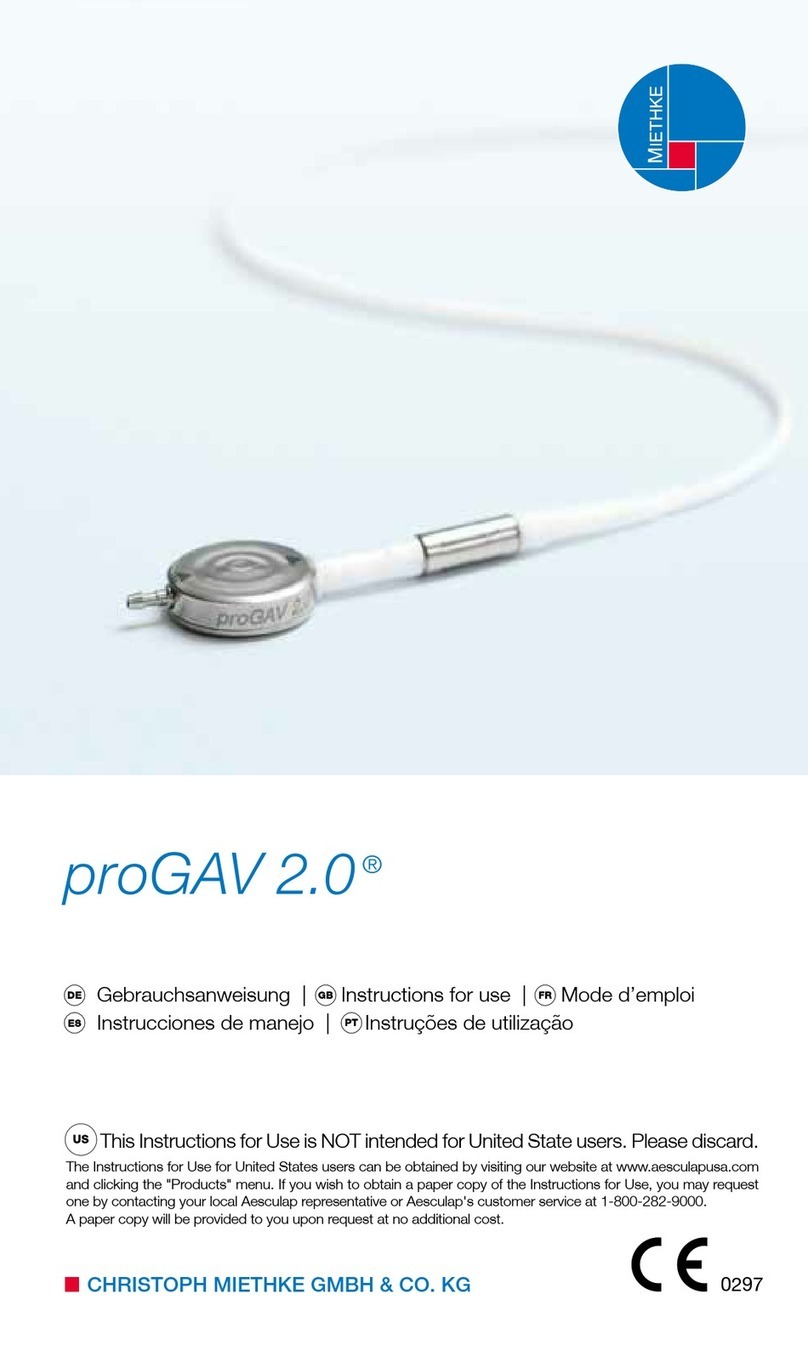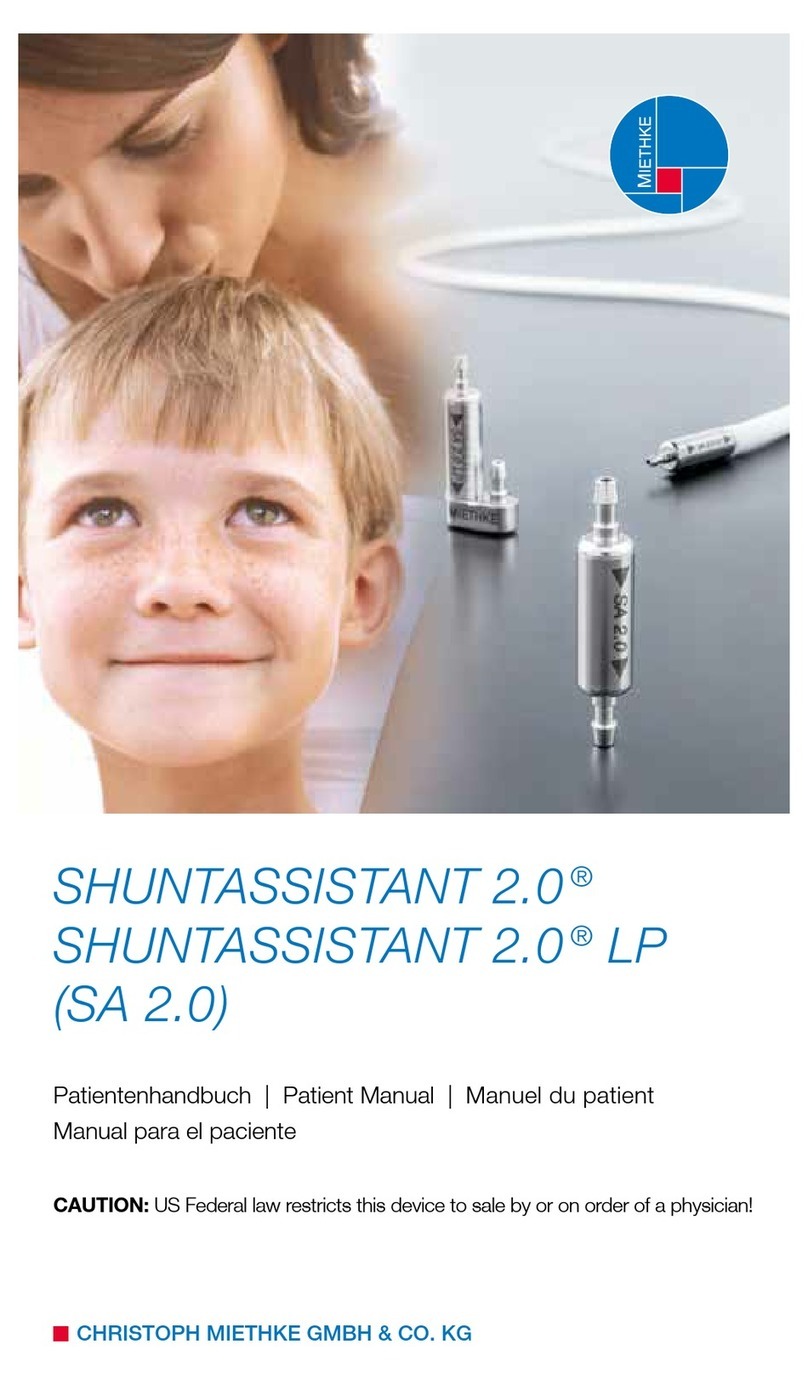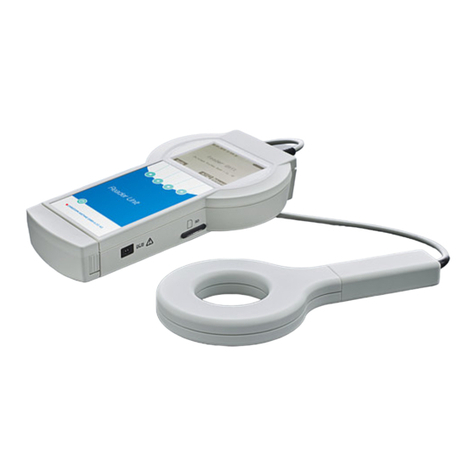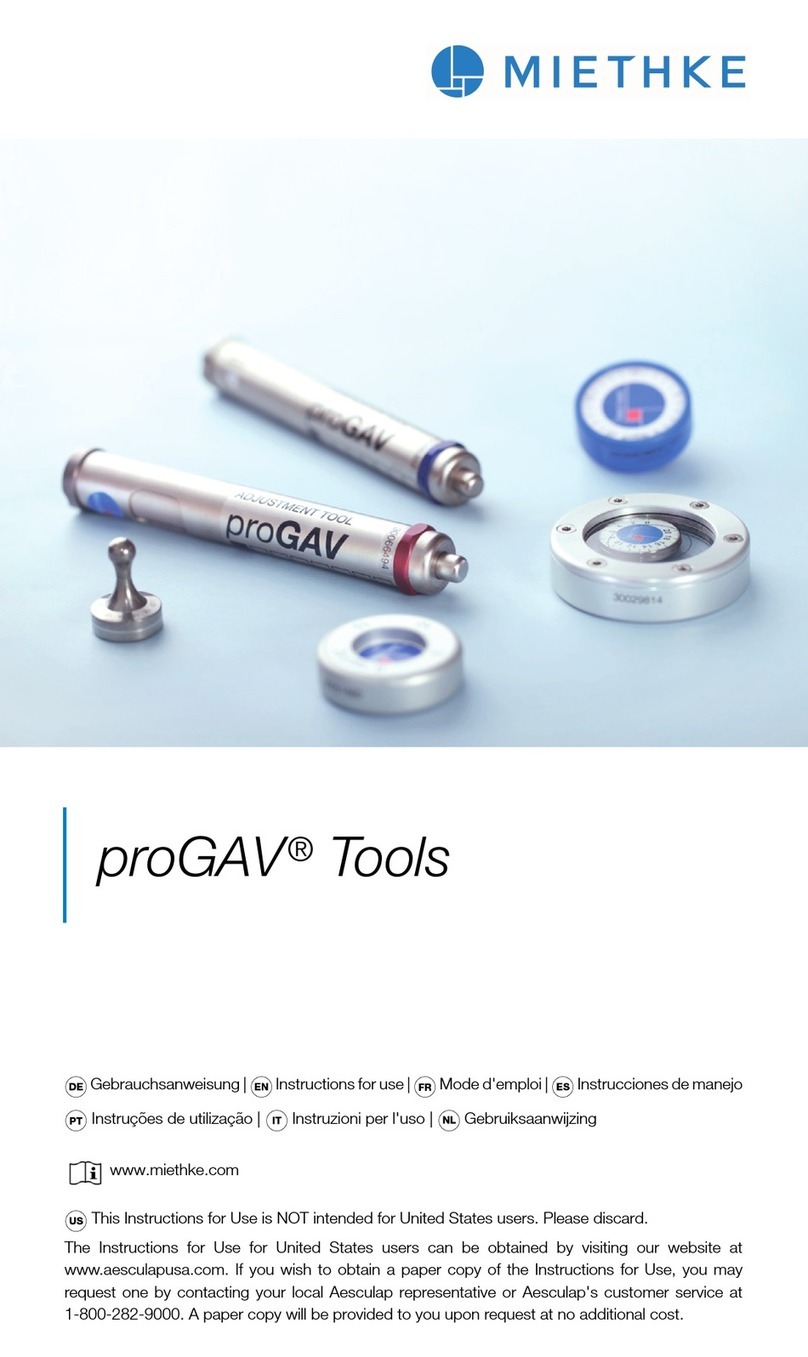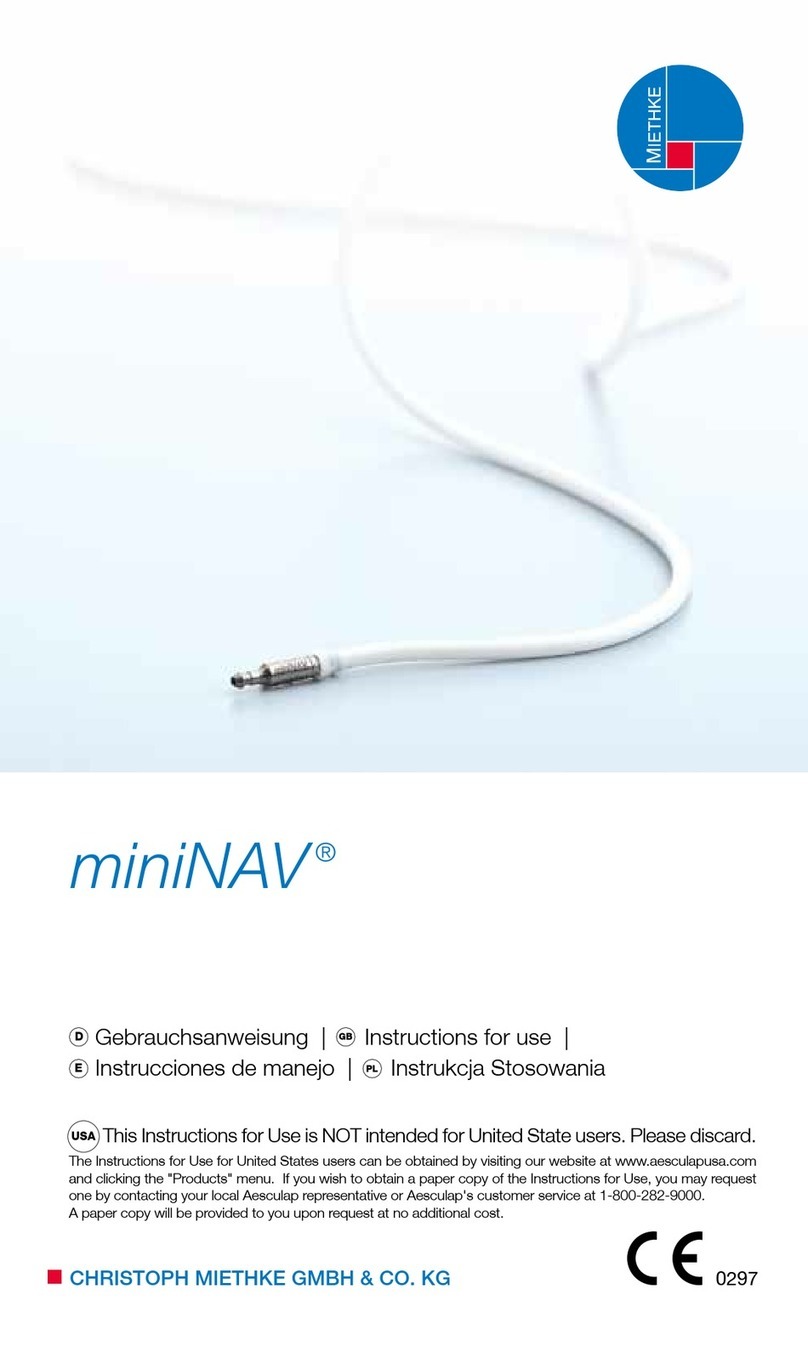MIETHKE GAV User manual

CAUTION
Federal law restricts this device to sale by or on order of a physician!
USA
CHRISTOPH MIETHKE GMBH & CO. KG 0297
Patientenhandbuch | Patient Handbook | Manuel du patient
Manual para el paciente | Manuale per il paziente
DF
E I
GB
Gravity Assisted Valve
(GAV ®)


Abb. 1, Fig. 1
Abb. 9, Fig. 9
1
2
3
4
5
6
1
2
3
4
a
b


5
PATIENTENHANDBUCH |D
DAS UNTERNEHMEN
Die Christoph Miethke GmbH & Co. KG ist ein
Brandenburger Unternehmen, das sich mit der
Entwicklung, der Produktion und dem Vertrieb von
innovativen neurochirurgischen Implantaten zur
Behandlung des Hydrocephalus beschäftigt. Wir
arbeiten hierbei erfolgreich mit Kliniken weltweit
zusammen.
Diese Broschüre soll Ihnen und Ihrer Familie einen
Einblick in die Behandlung des Hydrocephalus ge-
ben. Erst seit den 50er Jahren ist es möglich, diese
Krankheit erfolgreich zu behandeln. Der Techni-
ker John D. Holter hatte in einem dramatischen
Wettlauf um das Leben seines an Hydrocephalus
leidenden Sohnes Casey in Philadelphia in weni-
gen Wochen ein Silikon-Ventil entwickelt. Obwohl
sich dieses Ventil nach seiner Implantation im März
1956 klinisch bewährt hatte und einen großen
Schritt in der Behandlung dieser Krankheit dar-
stellt, gibt es bis heute eine erhebliche Anzahl von
Patienten, die mit Ventilsystemen große Probleme
haben.
Die Christoph Miethke GmbH & Co. KG hat die Er-
kenntnisse von 50 Jahren Ventilbehandlung aufge-
griffen und durch die Verwendung des Werkstoffs
Titan eine neue Generation von hochpräzisen
Ventilen entwickelt. Erstmals stehen Ventilsysteme
zur Verfügung, die konsequent die physikalischen
Randbedingungen der Hirnwasserableitung be-
rücksichtigen und so einen physiologischen Hirn-
druck unabhängig von der Körperlage einstellen.
Abb. 1: Anatomische Darstellung des Schädels
(siehe Umschlaginnenseite)
1) Schädeldecke
2) Gehirn
3) Hirnwasser (Liquor)
4) Seitlicher Ventrikel
5) Dritter Ventrikel
6) Vierter Ventrikel
ANATOMISCHE GRUNDLAGEN
Das menschliche Gehirn (Abb. 1) ist von einer
speziellen Flüssigkeit, dem Hirnwasser (Liquor),
umgeben. Im Inneren des Kopfes befinden sich
mehrere Hirnkammern, so genannte Ventrikel,
in denen das Hirnwasser produziert wird. Die
Ventrikel sind durch Kanäle untereinander ver-
bunden und stellen ein komplexes Ableitungs-
system dar. Das Wasser zirkuliert durch diese Hirn-
kammern und wird schließlich in das venöse Blut
abgegeben. Die Aufgabe des Hirnwassers besteht
darin, das Gehirn vor mechanischer Schädigung
zu schützen. Zusätzlich regelt es den Hirninnen-
druck, hält das Hirngewebe feucht und transpor-
tiert die Stoffwechselprodukte.
KRANKHEITSBILD
Beim gesunden Menschen existiert ein Gleichge-
wicht zwischen Produktion und Resorption des
Hirnwassers. Die täglich produzierte Flüssigkeits-
menge liegt beim Säugling bei ca. 100 ml, beim
Kleinkind bei ca. 250 ml und beim Erwachsenen
bei ca. 500 ml. Wird mehr Liquor gebildet als abge-
baut werden kann, kommt es zur Vergrößerung der
Hirnkammern, dem so genannten Hydrocephalus
(Abb. 2). Der Begriff Hydrocephalus beschreibt ei-
nen Zustand, bei dem „Wasser“ (Hydro) im „Kopf“
(Cephalus) ständig an Volumen zunimmt. Dieser
Zustand besteht oft schon bei der Geburt (ange-
borener Hydrocephalus). Er kann sich aber auch
im späteren Leben ausbilden, z.B. durch eine Ent-
zündung oder Blutung, durch eine schwere Verlet-
zung am Kopf oder infolge einer Hirnoperation. In
diesen Fällen spricht man von einem erworbenen
Hydrocephalus.
Man unterscheidet außerdem zwischen dem Hy-
drocephalus occlusus (nicht kommunizierender
Hydrocephalus) und dem Hydrocephalus commu-
nicans (kommunizierender Hydrocephalus). Beim
Hydrocephalus occlusus ist die Verbindung zwi-
schen den Hirnkammern unterbrochen, so dass
sie nicht miteinander „kommunizieren“ können.
Wenn die Ventrikel miteinander frei verbunden sind,
aber eine Störung der Hirnwasserresorption be-
steht, liegt ein Hydrocephalus communicans vor.
a) b)
Abb. 2: Ventrikelgröße
a) normal b) Hydrocephalus

6
| PATIENTENHANDBUCH
D
6
KRANKHEITSSYMPTOME
Im Säuglingsalter sind die Schädelknochen noch
nicht fest verwachsen. Das zunehmende Hirnwas-
ser führt hier zu einer Zunahme des Kopfumfangs
unter gleichzeitigem Abbau von Hirngewebe. Ab
einem Alter von ca. 2 Jahren wird durch den har-
ten Schädel eine Vergrößerung des Kopfumfangs
verhindert. Hier führt die Flüssigkeitszunahme zu
einem enormen Druckanstieg, wodurch sich die
Hirnkammern erweitern und das Gehirn kompri-
miert wird. Sowohl beim Säugling als auch beim
Erwachsenen können irreversible Gehirnschäden
auftreten. Je nach Grad der Störung kommt es zu
Übelkeit, Kopfschmerzen, Erbrechen, Koordinati-
onsstörung, Schläfrigkeit und schließlich Bewusst-
losigkeit.
DIAGNOSE DER ERKRANKUNG
Dem Arzt stehen heute verschiedene Möglich-
keiten zur Diagnose eines Hydrocephalus zur
Verfügung. Mittels bildgebender Verfahren (z. B.
Computertomographie, Ultraschall oder Magnetre-
sonanztomographie) wird die Größe der Ventrikel
bestimmt.
Computertomographie (CT)
Bei dieser schnellen und schmerzlosen Unter-
suchung werden durch Röntgenstrahlung Abbil-
dungen der verschiedenen Schichten des Kopfes
erzeugt.
Magnetresonanztomographie (MRT)
Dieses schmerzlose bildgebende Verfahren lie-
fert durch elektromagnetische Wellen sehr feine
Schichtbilder des Kopfes. Es wird auch als Kern-
spinresonanztomographie bezeichnet.
Ultraschall
Nur bei kleinen Kindern kann bei diesem Verfahren
durch die offene Fontanelle das Kopfinnere unter-
sucht werden.
Durch Druckmessungen kann eine Erhöhung des
Hirndrucks festgestellt werden. Kontrastmittelun-
tersuchungen dienen der Untersuchung der Hirn-
wasserzirkulation.
BEHANDLUNGSMETHODEN
Obwohl es immer Bemühungen gab, alternative
Therapiemöglichkeiten zur Ventilimplantation zu
finden, beispielsweise durch die Behandlung mit
Medikamenten oder in jüngster Zeit auch durch
minimalinvasive chirurgische Eingriffe, gibt es bis
heute in den meisten Fällen keine Alternative zur
Implantation eines Ableitungssystems, des so ge-
nannten „Shunts“.
4
3
7
8
1 Rechter Herzvorhof
2 Herzkatheter (atrialer Katheter)
3 Ventil
4 Reservoir
5 Hirnkammerkatheter (Ventrikelkatheter)
6 Hirnkammern
7 Bauchhöhlenkatheter (Peritonealkatheter)
8 Bauchhöhle
4
2
1
5
6
3
Abb. 3: Ableitungssysteme
a) ventrikulo-atrial b) ventrikulo-peritoneal
THERAPIE-KOMPLIKATIONEN
Die Behandlung des Hydrocephalus mit einem
Shuntsystem ist nicht immer komplikationslos. Es
kann wie bei jedem chirurgischen Eingriff zu einer
Infektion kommen. Leider treten auch teilweise
Probleme auf, die direkt oder indirekt mit dem
implantierten Ventilsystem in Verbindung stehen
können. Solche Komplikationen sind Verstop-
fungen des Ableitungssystems oder die ungewollt
erhöhte Ableitung des Hirnwassers. Um den phy-
sikalischen Hintergrund zu verstehen, warum sich
Ihr Arzt in Ihrem Fall für das GAV entschieden hat,
wird im Kapitel “physikalische Grundlagen” erklärt.

7
PATIENTENHANDBUCH |D
VERHALTEN NACH DER OPERATION
Die Patienten, die mit Ventilsystemen versorgt wer-
den, sind im Normalfall in ihrem täglichen Leben
nicht eingeschränkt. Vor erhöhten Anstrengungen
(körperlich schwere Arbeit, Sport) sollte der behan-
delnde Arzt befragt werden. Treten beim Patienten
starke Kopfschmerzen, Schwindelanfälle, unnatür-
licher Gang oder Ähnliches auf, sollte unverzüglich
ein Arzt aufgesucht werden.
PHYSIKALISCHE GRUNDLAGEN
Beim gesunden Menschen ist der Hirninnendruck
(hier dargestellt durch Wasserspiegel im Hirnkam-
merbehälter) in der liegenden Körperposition leicht
positiv und in der stehenden 0 oder sogar leicht
negativ (Abb. 4).
1 Hirnkammerbehälter
2 Hirnkammer
0
12
Abb. 4a: Hirnkammerdruck beim gesunden Menschen in
liegender Position
Abb. 4b: Hirnkammerdruck beim gesunden Menschen in
stehender Position
0
1
Besteht ein Hydrocephalus, ist der Hirn-
innendruck unabhängig von der Körperlage er-
höht, die Hirnkammern sind erweitert (Abb. 5).
Abb. 5a: Hirnkammerdruck beim kranken
Menschen in liegender Position
1 Hirnkammerbehälter
2 Erweiterte Hirnkammer
0
1 2
0
1
Abb. 5b: Hirnkammerdruck beim kranken
Menschen in stehender Position
Es ist jetzt dringend erforderlich, den Hirninnen-
druck unabhängig von der Körperhaltung zu sen-
ken und ihn in normalen Grenzen zu halten.
Hierzu wird ein „Shunt“ implantiert, der eine Verbin-
dung zwischen dem Kopf und der Bauchhöhle her-
stellt, um das überschüssige Hirnwasser abzulei-
ten. Aufgrund von Änderungen der Körperposition
kommt es ständig zu erheblichen physikalischen
Veränderungen im Ableitungssystem.
Sowohl die Bauchhöhle als auch die Hirnkammern
können vereinfacht als offene Gefäße angesehen
werden, die durch einen Schlauch verbunden sind.
Solange der Patient liegt (Kopf und Bauch befinden
sich in der gleichen Höhe) und kein Ventil in das
Ableitungssystem integriert ist, haben beide Was-
seroberflächen die gleiche Höhe, es handelt sich
um kommunizierende Gefäße (Abb. 6).

8
| PATIENTENHANDBUCH
D
1 Hirnkammerbehälter
2 Hirnkammer
3 Ableitungsschlauch
4 Bauchhöhle
5 Bauchhöhlenbehälter
6 Bluterguss
7 verkleinerte Hirnkammern
Abb. 6: Hirnwasserableitung nur mit Schlauch, ohne Ventil
a) liegend b) stehend
0
a) 1 2 3 4 5
b)
1
5
6
7
3
4
0
0
Die Bauchhöhle kann vereinfacht als Überlaufgefäß
aufgefasst werden. Wenn in den Behälter, der die
Hirnkammern darstellt, zusätzlich Flüssigkeit gefüllt
wird, bleibt der Wasserspiegel im Hirnkammerbe-
hälter gleich, denn die Flüssigkeit wird schnell in die
Bauchhöhle abgeleitet. Steht der Patient auf, befin-
den sich die Hirnkammern wesentlich höher als die
Bauchhöhle. Es kommt jetzt so lange zu einer Ab-
leitung des Hirnwassers durch den Schlauch, bis
beide Wasseroberflächen wieder die gleiche Höhe
haben. In diesem Fall ist aber der Hirnkammer-
behälter völlig leer gelaufen. Da die Hirnkammern
keine starren Behälter sind, führt das Leerlaufen
zum Zusammenziehen der Hirnkammern. Eine
Folge hiervon kann der angesprochene Verschluss
des Ableitungssystems sein. Das Hirnwasser
wird übermäßig herausgesaugt, das Gehirn wird
deformiert. Durch diese Überdrainage kann es im
Gehirn zu Wasser- oder Blutansammlungen zwi-
schen Gehirn und Schädelknochen kommen.
Wird ein konventionelles Ventil in das Ableitungs-
system eingesetzt, bewirkt dies eine Erhöhung des
Wasserspiegels im Hirnkammerbehälter um den
Öffnungsdruck des Ventils. Jetzt wirken die Hirn-
kammerbehälter und die Bauchhöhlenbehälter erst
dann zusammen wenn das Ventil geöffnet ist. Steht
der Patient auf, wird so lange Hirnwasser abgelei-
tet, bis die Höhendifferenz zwischen den beiden
Behältern der liegenden Körperlage erreicht ist. Der
Öffnungsdruck des Ventils, der für die liegende Po-
sition ausgelegt ist, liegt aber wesentlich unter der
schon beschriebenen Höhendifferenz zwischen
den Hirnkammern und der Bauchhöhle. Auch in
diesem Fall werden die Hirnkammern leergesaugt
und es kommt zu den angesprochenen Problemen
(Abb. 7).
1 Hirnkammerbehälter
2 Hirnkammer
3 Ableitungsschlauch
4 Bauchhöhle
5 Bauchhöhlenbehälter
6 Bluterguss
7 verkleinerte Hirnkammern
8 Differenzdruckventil
a) 1 2 3 4 5
x
b)
1
5
8
6
7
3
4
x
0
Abb. 7: Hirnwasserableitung mit konventionellem Ventil
a) liegend b) stehend
Das einfache Schema macht deutlich, wie wichtig
es ist, ein Ventil zu implantieren, das für die stehen-
de Position einen wesentlich höheren Öffnungs-
druck hat (entsprechend dem Abstand zwischen
Gehirn und Bauch) als für die liegende Position.
Das GAV ist ein solches Ventil. In jeder Körperpo-
sition stellt es den für den Patienten erforderlichen
Hirninnendruck ein. Die beschriebenen Probleme
und Komplikationen werden vermieden, indem die
ungewollte Ableitung einer erhöhten Menge von
Hirnwasser verhindert wird (Abb. 8).

9
PATIENTENHANDBUCH |D
x = Ventilöffnungsdruck in der liegenden Position
1 Hirnkammerbehälter
2 Hirnkammer
3 Ableitungsschlauch
4 Bauchhöhle
5 Bauchhöhlenbehälter
6 GAV
Abb. 8: Hirnwasserableitung mit dem GAV
a) liegend b) stehend
x
b)
a) 1 2 3 4 5
1
6
5
2
3
4
0
VENTILMECHANISMUS
Das GAV nutzt die Schwerkraft, um abhängig von
der Körperposition des Patienten einen Hirndruck
einzustellen, der sich an Werten des gesunden
Menschen orientiert.
Abb. 9: Funktionszeichnung des GAV
(siehe Umschlaginnenseite)
a Kugel-Konuseinheit
b Gravitationseinheit
1 Kodierring
2 Spiralfeder
3 Tantalkugel
4 Saphirkugel
Ein Federventil steuert den Hirndruck, wenn der
Patient liegt. Sobald sich der Patient aufrichtet,
wird eine schwere Tantalkugel aktiviert, die zu-
sätzlich durch ihre Schwerkraft eine Erhöhung des
Ventilöffnungsdrucks ermöglicht. Je aufrechter sich
der Oberkörper des Patienten ist, desto größer ist
der Öffnungsdruck des GAV. Das ist notwendig,
da sich der Höhenunterschied zwischen Hirnkam-
mern und Bauchhöhle vergrößert (siehe physika-
lische Grundlagen).
Das GAV besteht aus ausschließlich hochwertigen
Materialien, die für die Anwendung als Implantat-
werkstoffe erprobt und normiert sind, Hauptbe-
standteil ist Titan.
Durch das stabile Gehäuse werden Einflüsse (z. B.
Druck von außen) auf die Ventilfunktion auf ein ver-
nachlässigbares Minimum reduziert.
Somit sind eine hohe Funktionssicherheit und da-
mit eine lange Lebensdauer garantiert.
Abb. 10: GAV im Maßstab 1:1
27,4 mm
Ø 4,6 mm
Warnhinweis: Das Ventilsystem kann ein pump-
bares Reservoir enthalten. Da häufiges Pumpen
zu einer übermäßigen Wasserableitung und
damit zu sehr ungünstigen Druckverhältnissen
führen kann, sollte dieser Vorgang dem Arzt vor-
behalten bleiben.
PATIENTENPASS
Jedem GAV liegt ein Patientenpass bei. Dieser wird
vom behandelnden Arzt ausgefüllt und enthält so
alle wichtige Informationen für die Nachuntersu-
chungen.
0

10
| PATIENTENHANDBUCH
D
KLEINES PATIENTENLEXIKON
Anatomie
Lehre vom Bau der Körperteile
Arachnoidea Spinnwebenhaut;
bindegewebige Membran, die sich über Furchen
und Windungen des Gehirns und das Rückenmark
zieht
Computer-Tomographie (CT)
Bildgebendes Verfahren, bei dem durch Röntgen-
strahlung Schichtbilder erzeugt werden
Drainage
Ableitung einer Flüssigkeitsansammlung
Dura mater
Harte Hirnhaut
Fontanelle
Bindegewebige Knochenlücke am kindlichen
Schädel, die später verknöchert
Hirnventrikel
Mit Hirnwasser gefüllte Gehirnkammer
Implantat
Produkt, das zur Erfüllung bestimmter Ersatzfunk-
tionen für einen begrenzten Zeitraum oder auf Le-
benszeit in den menschlichen Körper eingebracht
wird
Katheter
Schlauch
Kommunizierende Gefäße
Gefäße, die über einen Kanal miteinander verbun-
den sind
Leptomeninx
Weiche Hirnhaut, die sich unterteilt in Arachnoidea
und Pia mater
Liquor (liquor cerebrospinalis)
Gehirn-Rückenmark-Flüssigkeit oder Hirnwasser
Liquorbestandteile
Hirnwasserbestandteile
Lumbalpunktion
Punktion des Rückenmarkskanals am unteren Teil
der Wirbelsäule
Lumbo-peritoneale Ableitung
Ableitung des Hirnwassers aus der Hirnkammer
über den Lendenwirbelbereich in die Bauchhöhle
Meningen
Hirn- bzw. Rückenmarkshäute
Meningitis
Entzündung der Hirnhaut
Minimalinvasiv
Minimal eindringend
Peritoneum
Haut, die die Bauch- und Beckenhöhle auskleidet
Pia mater
Gefäßführender Teil der weichen Hirnhaut
Punktion
Einstich einer Hohlnadel oder eines Trokars in Ge-
fäße zur Entnahme von Flüssigkeiten
Resorption
Aufsaugung bzw. Aufnahme von Stoffen über
Haut, Schleimhaut oder Gewebe
Rückenmark
Im Wirbelkanal eingeschlossener Teil des Zentra-
len Nervensystems
Shunt
Kurzschlussverbindung, hier Katheterableitungs-
system mit integriertem Ventil
Subdurales Hämatom
Blutgerinnsel zwischen Gehirn und Schädeldecke
Subkutandruck
Druck unter der Haut
Überdrainage
Ungewollter, erhöhter Abfluss von Hirnwasser
Ventrikulo-peritoneale Ableitung
Ableitung des Hirnwassers aus der Hirnkammer
direkt in die Bauchhöhle (Bauchhöhlenkatheter)

11
PATIENTENHANDBUCH |D
NACHUNTERSUCHUNGEN
Eine Nachuntersuchung ist in jedem Fall erforderlich.
Datum Behandlung
Notizen und Anmerkungen

12
| PATIENT HANDBOOK
GB
THE COMPANY
Christoph Miethke GmbH & Co. KG is a Branden-
burg-based company that develops, manufactures
and markets innovative neurosurgical implants for
the treatment of hydrocephalus. In this, we work
in successful partnerships with numerous hospitals
worldwide.
The purpose of this booklet is to provide you and
your family with some understanding of the treat-
ment of hydrocephalus. The successful treatment
of this condition has only been possible since the
1950s. In a dramatic race against time to save the
life of his son, Casey, who suffered from hydroce-
phalus, a technician named John D. Holter deve-
loped, in only a few weeks, a novel silicone valve.
Despite the fact that, since its first implantation in
March 1956, this valve has proven to be clinically
effective and a giant step in the treatment of this
condition, there are many patients today who ex-
perience considerable problems with hydrocepha-
lus valve systems.
Christoph Miethke picked up the knowledge gained
in 50 years of valve treatment and developed a
new generation of highprecision valves made of
the metal titanium. For the first time, there are valve
systems available that consistently take into ac-
count the physical conditions of brain fluid drai-
nage and can thus maintain a physiological brain
pressure, independent of the body position of the
patient.
Fig. 1: Anatomic sketch of the cranium (inner cover page)
1) skull pan
2) brain
3) cerebrospinal fluid
4) lateral ventricle
5) third ventricle
6) fourth ventricle
BASIC ANATOMY
The human brain (fig. 1) is surrounded by a spe-
cial fluid known as cerebrospinal fluid (CSF). Ce-
rebrospinal fluid is produced in several chambers,
so-called ventricles, that are found within the brain.
The channels, by which the ventricles are intercon-
nected, constitute a complex drainage system.
The fluid in the brain circulates through these
ventricles and eventually flows into the venous
blood. The function of this fluid is to protect the
brain from mechanical damage. The CSF also
regulates the internal brain pressure (intracranial
pressure, ICP), keeps the brain tissue moist and
transports the products of metabolism.
CLINICAL PICTURE OF THE CONDITION
In healthy humans, a balance exists between the
production and resorption of cerebrospinal fluid.
In infants, approx. 100 ml of this fluid is produced
every day; in small children, the daily production
is approx. 250 ml, in adults approx. 500 ml. If the
amount of fluid produced exceeds the amount re-
sorbed, the ventricles expand, leading to the con-
dition known as hydrocephalus (fig. 2). The term
hydrocephalus refers to the continuous increase
of the volume of “water” (hydro) in the “head” (ce-
phalus). This condition is often observed at birth
(congenital hydrocephalus), but it can also deve-
lop later in life, e.g., as the result of inflammation,
hemorrhage or severe head injury, or after brain
surgery. Such cases are referred to as acquired
hydrocephalus.
A further distinction is made between obstructive
hydrocephalus and communicating hydrocepha-
lus. In obstructive hydrocephalus, the links bet-
ween the ventricles of the brain are interrupted
so that the ventricles cannot “communicate” with
each other. Cases in which the ventricles are in-
terlinked through open channels, but resorption of
cerebrospinal fluid is impaired, are diagnosed as
communicating hydrocephalus.
a) b)
Fig. 2: Ventricle size
a) normal, b) hydrocephalus

13
PATIENT HANDBOOK GB
CLINICAL SYMPTOMS OF THE CONDITION
In infants, the cranial bones have not adhered so-
lidly yet. The increasing volume of cerebrospinal
fluid causes the head to increase in circumference
while, at the same time, brain tissue disintegrates.
From the age of about 2, the hardened skull pre-
vents any growth of the head‘s circumference. In
that situation, the increase in fluid volume leads to
a massive pressure rise, resulting in the expansion
of the brain ventricles and the compression of the
brain itself. The consequence for infants and adults
can be irreversible brain damage. Symptoms (de-
pending on the severity of the disorder) include
nausea, headache, vomiting, impaired coordinati-
on, drowsiness and, in the end, unconsciousness.
DIAGNOSIS OF THE CONDITION
Doctors have a variety of ways at their disposal
to diagnose hydrocephalus. The ventricle size
is measured through imaging procedures (e.g.
computerized tomography, ultrasound or NMR-
tomography).
Computerized tomography (CT)
This quick and painless diagnostic procedure pro-
duces X-ray images of different layers of the head.
Nuclear Magnetic Resonance (NMR) tomography
This painless electromagnetic imaging process
produces images of very fine layers of the head.
It is also known as NMR, MRT, or MRI scanning.
Ultrasound
This procedure, in which the interior of the head is
examines through the open fontanel, can only be
applied to small children.
Another way of diagnosing hydrocephalus is
through pressure measurements showing an incre-
ased brain pressure. The circulation of cerebrospi-
nal fluid is investigated through examinations with
contrast agents.
METHODS OF TREATMENT
For all the efforts to find therapeutic alternatives to
valve implantation (e. g. through pharmaceutical
treatment or, most recently, by minimally invasive
surgery), there is currently no alternative, in most
cases, to the implantation of a drainage system,
referred to as a shunt.
Fig. 3: Drainage systems for hydrocephalus patients
a) ventriculo-atrial, b) ventriculo-peritoneal
1 right atrium
2 heart catheter (atrial catheter)
3 valve
4 reservoir
5 ventricular catheter
6 ventricles
7 abdominal catheter (peritoneal catheter)
8 abdominal cavity
4
2
1
5
6
3
a)
7
8
4
3
b)
THERAPY COMPLICATIONS
The treatment of hydrocephalus with a shunt sys-
tem can sometimes arise complications. As is the
case for any surgical intervention, there is a risk of
infection. There can also be complications that are
directly or indirectly related to the implanted val-
ve system. Such complications include blockages
of the drainage system or inadvertently increased
fluid drainage. To give you an understanding why
your physician decided for the GAV, the physics
of drainage is explained in the chapter “Physics
background“.

14
| PATIENT HANDBOOK
GB
AFTER THE OPERATION
As a rule, the everyday activities of patients with
shunt implants are not restricted. However, pati-
ents should consult their attending physician be-
fore major physical exertion (e. g. hard physical
work, strenuous sports). Hydrocephalus patients
who experience headache, dizziness, unnatural
gait or similar symptoms should consult a physi-
cian without delay. Apart from that, we recommend
medical check-ups at regular intervals. The patient
should avoid knocks or pressure on the valve and
catheters. The valve has been designed to be resi-
stant against magnetic fields.
PHYSICS BACKGROUND
In the following chapter we describe the pressure
conditions relevant for hydrocephalus drainage.
The ventricle pressure and the pressure in the ab-
dominal cavity are represented by water levels.
In a healthy human, the ventricular pressure (water
level in the ventricle container) is positive (slightly
above 0) in the horizontal position and negative
(slightly below 0) in the upright (vertical) position
(fig. 4).
Fig. 4a: Ventricle pressure in a healthy
human in horizontal position
1 ventricle container
2 ventricles
12
0
Fig. 4b: Ventricle pressure in a healthy
human in vertical position
0
1
In hydrocephalus patients the ventricular pressure
is always increased (water level in the ventricle con-
tainer far above 0) irrespective of the body position.
The ventricles are expanded (fig. 5).
1 ventricle container
2 expanded ventricles
0
12
Fig. 5a: Ventricle pressure in a hydrocephalus patient in
horizontal position
0
1
Fig. 5b: Ventricle pressure in a hydrocephalus patient in
vertical position

15
PATIENT HANDBOOK GB
Now there is an urgent need to lower the intracra-
nial pressure und keep it within normal limits, in-
dependent of the body position. Finally, excessive
cerebrospinal fluid is drained into the abdominal
cavity. Due to changes in the patient’s body posi-
tion, the drainage system is subject to incessant,
considerable physical changes. Fig. 6 shows the
effects on the intracranial pressure when a tube is
implanted, although there has been no valve inte-
grated in the drainage system yet.
For simplicity, the abdominal pressure as well as
the ventricles can be regarded as open vessels,
which are now connected by a tube. As long as
the patient is lying down (head and abdomen at
the same height) and no valve is integrated in the
drainage system, both water levels are at the same
height, too: It is a system of communicating ves-
sels. In a simplified picture, the abdomen can be
regarded as an overflow vessel. Even if more fluid
is filled into the ventricle container, the water level in
it will remain at the same height, because the fluid
is instantly drained into the abdomen.
When the patient stands up, the ventricles are at a
significantly higher level than the abdomen. In this
case, the fluid is drained through the tube until both
water levels are at the same height. This means,
however, that the ventricle container is emptied
completely. Since the ventricles do not have rigid
walls, this emptying leads to a contraction of the
ventricles. This, in turn, can result in the above
mentioned blockage of the drainage system. The
cerebrospinal fluid is sucked out of the ventricles
and the brain suffers deformation. And when the
brain contracts, the resulting open space between
brain and skull bone can fill up with water or blood
(fig. 6).
Fig. 6: Ventricle drainage without a valve
a) horizontal, b) vertical
1 ventricle container
2 ventricle
3 drainage tube
4 abdominal cavity
5 abdominal container
6 accumulated water or blood
7 contracted ventricles
0
a) 1 2 3 4 5
b)
0
1
5
6
7
3
4
0
A conventional valve integrated into the drainage
system causes a rise of the water level in the ventri-
cle container, by exactly the opening pressure of
the valve. Now, the two containers “communicate”
only when the valve is open. When the patient
stands up, cerebrospinal fluid is drained off until
the height difference between the two containers
for the horizontal position is reached. However, the
opening pressure of the valve, which was adjusted
for the horizontal position, is considerably lower
than the pressure corresponding to the height dif-
ference between the ventricles and the abdomen.
Hence, the ventricles will still be drained empty,
resulting in the above mentioned problems (fig. 7).

16
| PATIENT HANDBOOK
GB
1 ventricle container
2 ventricle
3 drainage tube
4 abdominal cavity
5 abdominal container
6 accumulated water or blood
7 contracted ventricles
8 valve
Fig. 7: Ventricle drainage with conventional valve
a) horizontal, b) vertical
a) 1 2 3 4 5
x
b)
1
5
8
6
7
3
4
x
0
The following sketch demonstrates the importance
of implanting a valve that offers a significantly high-
er opening pressure for the vertical position (cor-
responding to the distance between the brain and
the abdomen) than for the horizontal position.
The GAV is such a valve. It sets the required intra-
cranial pressure for the patient in every body po-
sition. The problems and complications described
above are avoided by preventing any unintentional
overdrainage of cerebrospinal fluid (fig. 8).
x = opening pressure in horizontal position
1 ventricle container
2 ventricles
3 drainage tube
4 abdominal cavity
5 abdominal container
6 GAV
Fig. 8: Ventricle drainage with GAV
a) horizontal, b) vertical
x
a) 1 2 3 4 5
2
3
4
0
1
6
5
b)
TECHNICAL SPECIFICATIONS OF THE VALVE
Fig. 9: Schematic cross section of the GAV
(see inner cover page)
a) ball-cone valve
b) gravity valve
1) coding ring
2) coil spring
3) tantalum ball
4) sapphire ball
The GAV uses gravity to adjust, regardless of the
patient’s position, a ventricular pressure guided by
pressure values as in a healthy person. A ball-cone
valve controls the ventricular pressure when the
patient is lying down. As soon as the patient rises,
a heavy tantalum ball is brought into action which,
through its gravity, adjusts the valve to a higher
opening pressure. The closer the upper body of
the patient gets to the vertical position, the higher

17
PATIENT HANDBOOK GB
x = opening pressure in horizontal position
1 ventricle container
2 ventricles
3 drainage tube
4 abdominal cavity
5 abdominal container
6 GAV
Fig. 8: Ventricle drainage with GAV
a) horizontal, b) vertical
x
a) 1 2 3 4 5
2
3
4
0
1
6
5
b)
TECHNICAL SPECIFICATIONS OF THE VALVE
Fig. 9: Schematic cross section of the GAV
(see inner cover page)
a) ball-cone valve
b) gravity valve
1) coding ring
2) coil spring
3) tantalum ball
4) sapphire ball
The GAV uses gravity to adjust, regardless of the
patient’s position, a ventricular pressure guided by
pressure values as in a healthy person. A ball-cone
valve controls the ventricular pressure when the
patient is lying down. As soon as the patient rises,
a heavy tantalum ball is brought into action which,
through its gravity, adjusts the valve to a higher
opening pressure. The closer the upper body of
the patient gets to the vertical position, the higher
becomes the opening pressure of the GAV. This is
necessary, because the height difference between
the ventricles of the brain and the abdominal cavity
increases, see ”Physics background”.
The GAV is made only of high-grade materials
which have been tested and standardized for use
as implant materials, the main material being tita-
nium. The solid casing reduces external influences
(e.g. external pressure) on the functioning of the
valve to a negligible minimum. Hence a high level
of functional reliability and a long service life are
guaranteed.
Fig. 10: GAV, scale 1:1
27,4 mm
Ø 4,6 mm
Warning note: The shunt system may comprise
a reservoir that can be pumped. Since frequent
pumping may lead to overdrainage and thus
to very unfavorable pressure conditions, such
pumping should only be carried out by the phy-
sician.
PATIENT ID
Each GAV is delivered with a Patient ID which is fil-
led out by the attending physician. This document
will then hold important information for follow-up
examinations.

18
| PATIENT HANDBOOK
GB
A BRIEF PATIENT GLOSSARY
Anatomy
A guide to the structure of body components
Arachnoid
Connective tissue in the brain that lies between the
dura mater and the pia mater
Catheter
Tube
Cerebrospinal fluid
Watery spinal fluid in the brain
Communicating vessels
Vessels that are connected by a channel
Computed tomography (CT)
Imaging technique whereby „slices“ of the body are
recorded with an X-ray scanner
Drainage
Drainage of accumulated fluid
Dura mater
The hardest component of the meninx
Fluid component
Cerebrospinal fluid component
Fontanel
Connective tissue opening in a young infant’s skull
that later ossifies
Implant
Substance that is placed in the human body to re-
place a particular function for a limited period of
time or for the rest of the patient’s life
Lumbar puncture
Puncture of the spinal channel at the lower spine
Lumboperitoneal drainage
Drainage of cerebrospinal fluid from the ventricle
of the brain, by way of the region of the lumbar
vertebrae in the abdominal cavity
Meninges
Membrane found in the brain and spine
Meningitis
Inflammation of the meninx
Minimally invasive
Minimally infiltrating
Overdrainage
Undesirable outward flow of cerebrospinal fluid
Peritoneum
Membrane that covers the pelvic and abdominal
cavities
Pia mater
Component of the soft meninx containing blood
vessels
Piaarachnoid
Soft component of the meninx that is divided into
the arachnoidea and pia mater
Puncture
Insertion of a hollow needle or a trocar into a vessel
for the purpose of removing fluid
Resorption
Suctioning or removal of material through skin, mu-
cosa, or tissue
Shunt
A passage between two channels – here a catheter
drainage system with an integrated valve
Spinal column
Element of the central nerous system located
within the vertebral channel
Subcutaneous pressure
Pressure beneath the skin
Subdural hematoma
An accumulation of blood between the brain and
cranium
Ventricle of the brain
Intracranial space containing cerebrospinal fluid
Ventricular peritoneal drainage
Drainage of cerebrospinal fluid from the ventri-
cle of the brain directly into the abdominal
cavity (abdominal catheter)

19
PATIENT HANDBOOK GB
FOLLOW-UP EXAMINATIONS
A follow-up examination must be carried out in all cases.
Date Treatment
Notes and comments

20
| MANUEL DU PATIENT
F
20
LA SOCIÉTÉ
La société Christoph Miethke GmbH & Co. KG est
une entreprise de Berlin-Brandebourg qui travaille
dans le développement, la production et la com-
mercialisation d’implants neurochirurgicaux nova-
teurs pour le traitement de l’hydrocéphalie. Dans
cette optique, nous coopérons avec succès avec
différentes cliniques à travers le monde.
Cette brochure a but de vous fournir, ainsi qu’à
votre famille, des informations sur le traitement de
l’hydrocéphalie. Ce n‘est que depuis les années
50 Il n’est possible de traiter cette maladie avec
des résultats positifs. À l’époque, à Philadelphie,
le technicien John D. Holter avait mis au point une
valve en silicone en quellques semaines, dans une
dramatique course contre la montre pour sauver la
vie de son fils Casey atteint d’hydrocéphalie. Bien
que cette valve, après sa première implantation en
mars 1956, ait fait ses preuves cliniques et consti-
tué une étape considérable dans le traitement de
cette maladie, il existe aujourd‘hui encore un très
grand nombre de patients souffrant d‘importants
problèmes liés aux systèmes de valves utilisés.
La société Christoph Miethke GmbH & Co. KG
s‘est inspirée des connaissances tirées de 50 an-
nées de traitement par valve et a mis au point une
nouvelle génération de valves de très haute précisi-
on, en utilisant comme matériau le titane.
Nous disposons ainsi pour la première fois de
systèmes de valves qui tiennent compte des con-
traintes physique de dérivation du liquide céphalo-
rachidien, et qui règlent une pression intracrâni-
enne indépendamment de la position du corps.
Fig. 1: Représentation anatomique du crâne
(couverture intérieure)
1) Calotte crânienne
2) Cerveau
3) Liquide céphalo-rachidien (LCR)
4) Ventricule latéral
5) Troisième ventricule
6) Quatrième ventricule
DONNÉES ANATOMIQUES DE BASE
Le cerveau humain (fig. 1) baigne dans un liquide
biologique particulier, appelé le liquide céphalo-
rachidien (LCR). L’intérieur du crâne comprend
plusieurs cavités cérébrales, appelées ventricules,
dans lesquelles est produit le LCR. Les ventricules
sont reliés entre eux par des canaux et constituent
un système de dérivation complexe. Le LCR circu-
le à travers ces cavités cérébrales pour être enfin
évacué dans le système veineux. Le rôle du LCR
est permettre la protection mécanique du cerveau.
Le LCR régule en outre la pression intracrânienne,
maintient la teneur en humidité des tissus céré-
braux et assure la distribution métaboliques.
SIGNES CLINIQUES
Chez le sujet en bonne santé, la production et la
résorption du liquide céphalorachidien est équi-
librée. La quantité de LCR produite quotidienne-
ment est d’env. 100 ml chez le nourrisson, d’env.
250 ml chez le petit enfant et d’env. 500 ml chez
l’adulte. Lorsque la quantité de LCR produite
excède les capacités de résorption. Il se produit
une dilatation des ventricules cérébraux, c‘est ce
que l‘on appelle l‘hydrocéphalie (fig. 2). Le terme
d’hydrocéphalie décrit un état dans lequel le liquide
(hydro-: eau) occupe un volume croissant dans la
tête (:-céphalie). Cet état se rencontre souvent dès
la naissance (hydrocéphalie congénitale). Il peut
toutefois également survenir plus tard, p. ex. à la
suite d’un état inflammatoire ou d’un saignement,
d’une blessure grave à la tête ou d’une opération
du cerveau.
a) b)
Fig. 2: Taille du ventricule
a) normale, b) avec hydrocéphalie
On parle dans ces cas d’hydrocéphalie ac-
quise. On distingue deux types d‘hydrocephalie:
l’hydrocéphalie obstructive (non communicante)
et l’hydrocéphalie normotensive (communicante).
Dans le cadre de l’hydrocéphalie obstructive, la li-
aison entre les cavités cérébrales est interrompue,
de sorte qu’elles ne communiquent plus entre elles.
Lorsque les ventricules communiquent librement
entre eux, mais qu’il y a un dysfonctionnement de
la résorption du LCR, il s‘agit d’une hydrocéphalie
communicante.
Table of contents
Languages:
Other MIETHKE Medical Equipment manuals
Popular Medical Equipment manuals by other brands

Getinge
Getinge Arjohuntleigh Nimbus 3 Professional Instructions for use

Mettler Electronics
Mettler Electronics Sonicator 730 Maintenance manual

Pressalit Care
Pressalit Care R1100 Mounting instruction

Denas MS
Denas MS DENAS-T operating manual

bort medical
bort medical ActiveColor quick guide

AccuVein
AccuVein AV400 user manual
